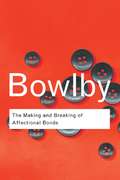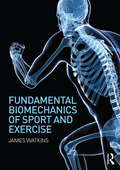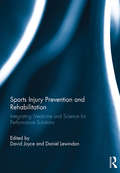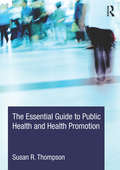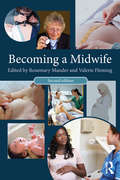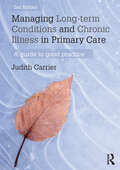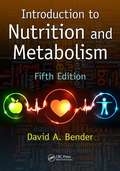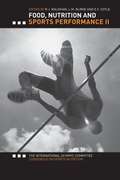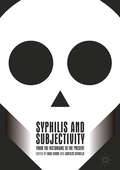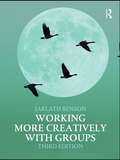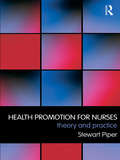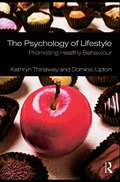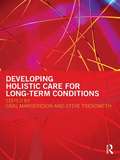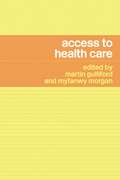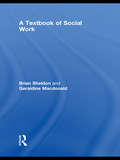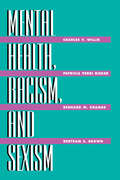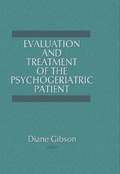- Table View
- List View
The Making and Breaking of Affectional Bonds
by John BowlbyHelping both parents and psychologists to arrive at a better understanding of the inner emotional world of the infant, this selection of key lectures by Bowlby includes the seminal one that gives the volume its title. Informed by wide clinical experience, and written with the author's well-known humanity and lucidity, the lectures provide an invaluable introduction to John Bowlby’s thought and work, as well as much practical guidance of use both to parents and to members of the mental health professions.
Fundamental Biomechanics of Sport and Exercise
by James WatkinsFundamental Biomechanics of Sport and Exercise is an engaging and comprehensive introductory textbook that explains biomechanical concepts from first principles, showing clearly how the science relates to real sport and exercise situations. The book is divided into two parts. The first provides a clear and detailed introduction to the structure and function of the human musculoskeletal system and its structural adaptations, essential for a thorough understanding of human movement. The second part focuses on the biomechanics of movement, describing the forces that act on the human body and the effects of those forces on the movement of the body. Every chapter includes numerous applied examples from sport and exercise, helping the student to understand how mechanical concepts describe both simple and complex movements, from running and jumping to pole-vaulting or kicking a football. In addition, innovative worksheets for field and laboratory work are included that contain clear objectives, a description of method, data recording sheets, plus a set of exemplary data and worked analysis. Alongside these useful features are definitions of key terms plus review questions to aid student learning, with detailed solutions provided for all numerical questions. No other textbook offers such a clear, easy-to-understand introduction to the fundamentals of biomechanics. This is an essential textbook for any biomechanics course taken as part of degree programme in sport and exercise science, kinesiology, physical therapy, sports coaching or athletic training.
Fundamental Biomechanics of Sport and Exercise
by James WatkinsFundamental Biomechanics of Sport and Exercise is an engaging and comprehensive introductory textbook that explains biomechanical concepts from first principles, showing clearly how the science relates to real sport and exercise situations. The book is divided into two parts. The first provides a clear and detailed introduction to the structure and function of the human musculoskeletal system and its structural adaptations, essential for a thorough understanding of human movement. The second part focuses on the biomechanics of movement, describing the forces that act on the human body and the effects of those forces on the movement of the body. Every chapter includes numerous applied examples from sport and exercise, helping the student to understand how mechanical concepts describe both simple and complex movements, from running and jumping to pole-vaulting or kicking a football. In addition, innovative worksheets for field and laboratory work are included that contain clear objectives, a description of method, data recording sheets, plus a set of exemplary data and worked analysis. Alongside these useful features are definitions of key terms plus review questions to aid student learning, with detailed solutions provided for all numerical questions. No other textbook offers such a clear, easy-to-understand introduction to the fundamentals of biomechanics. This is an essential textbook for any biomechanics course taken as part of degree programme in sport and exercise science, kinesiology, physical therapy, sports coaching or athletic training.
Sports Injury Prevention and Rehabilitation: Integrating Medicine and Science for Performance Solutions
by David Joyce Daniel LewindonWorld-class rehabilitation of the injured athlete integrates best practice in sports medicine and physical therapy with training and conditioning techniques based on cutting-edge sports science. In this ground-breaking new book, leading sports injury and rehabilitation professionals, strength and conditioning coaches, biomechanists and sport scientists show how this integrated model works across the spectrum of athlete care. In every chapter, there is a sharp focus on the return to performance, rather than just a return to play. The book introduces evidence-based best practice in all the core areas of sports injury risk management and rehabilitation, including: performance frameworks for medical and injury screening; the science of pain and the psychology of injury and rehabilitation; developing core stability and flexibility; performance retraining of muscle, tendon and bone injuries; recovery from training and rehabilitation; end-stage rehabilitation, testing and training for a return to performance. Every chapter offers a masterclass from a range of elite sport professionals, containing best practice protocols, procedures and specimen programmes designed for high performance. No other book examines rehabilitation in such detail from a high performance standpoint. Sports Injury Prevention and Rehabilitation is essential reading for any course in sports medicine and rehabilitation, strength and conditioning, sports science, and for any clinician, coach or high performance professional working to prevent or rehabilitate sports injuries.
The Essential Guide to Public Health and Health Promotion
by Susan R. ThompsonIn the twenty-first century, public health is everyone’s business. The nursing and medical professions are well placed to provide advice to their clients, especially in respect to lifestyle change, and public health initiatives are supported by a range of statutory and voluntary organisations and health workers, ranging from health promotion specialists to smoking cessation advisers and nutrition assistants. Designed to help readers develop the practical skills they need to become effective public health practitioners, this concise text gives an easily digested overview of public health and health promotion theory in accessible language and diagrams, before moving on to the ways readers can apply this in practice. Providing an opportunity for practitioners to understand possible barriers to lifestyle change, debate health inequalities and responsibilities, and explore the role of the media in changing attitudes, it: Outlines the roles of specific organisations involved in the work of public health work. Covers health needs assessment, agenda setting and the technical aspects of how to research plan and evaluate effective practice either with individual clients or when devising programmes and initiatives for population groups. Details methods of helping people with motivation for lifestyle change, building rapport, ongoing support, monitoring and signposting to specific services. Discusses role of neighbourhoods and communities in improving health and how workers may support local populations to improve the health of their community. The Essential Guide to Public Health and Health Promotion is an accessible introduction to the principles and practice of health promotion and public health for all those new to working or studying in the area, whatever their professional background.
The Essential Guide to Public Health and Health Promotion
by Susan R. ThompsonIn the twenty-first century, public health is everyone’s business. The nursing and medical professions are well placed to provide advice to their clients, especially in respect to lifestyle change, and public health initiatives are supported by a range of statutory and voluntary organisations and health workers, ranging from health promotion specialists to smoking cessation advisers and nutrition assistants. Designed to help readers develop the practical skills they need to become effective public health practitioners, this concise text gives an easily digested overview of public health and health promotion theory in accessible language and diagrams, before moving on to the ways readers can apply this in practice. Providing an opportunity for practitioners to understand possible barriers to lifestyle change, debate health inequalities and responsibilities, and explore the role of the media in changing attitudes, it: Outlines the roles of specific organisations involved in the work of public health work. Covers health needs assessment, agenda setting and the technical aspects of how to research plan and evaluate effective practice either with individual clients or when devising programmes and initiatives for population groups. Details methods of helping people with motivation for lifestyle change, building rapport, ongoing support, monitoring and signposting to specific services. Discusses role of neighbourhoods and communities in improving health and how workers may support local populations to improve the health of their community. The Essential Guide to Public Health and Health Promotion is an accessible introduction to the principles and practice of health promotion and public health for all those new to working or studying in the area, whatever their professional background.
Becoming a Midwife
by Rosemary Mander Valerie FlemingWhat is the reality of being a midwife in the twenty-first century? What is it like to help and support women throughout pregnancy and childbirth and into motherhood? What roles can midwives play in society? This new edition of the popular text, Becoming a Midwife, explores what it is to be a midwife, looking at the factors that make midwifery such a special profession, as well as some of the challenges. The fully updated chapters cover a variety of settings and several different stages in a woman’s pregnancy, including stories from midwives working in hospitals and in the community, as managers, supervisors and educators, and as men, women, mothers and birth activists. All chapters are narrated by contributors who introduce their own theme, recount a vignette that throws light on their understandings of midwifery and reasons for becoming (or not becoming) a midwife and any subsequent career moves. Backed up by commentaries and drawing together these insights, the editors show what it means to be a midwife today. Suitable for those contemplating a career in midwifery and providing an opportunity for reflection for more experienced midwives, this thought-provoking book is an invaluable contribution to midwifery.
Becoming a Midwife
by Rosemary Mander Valerie FlemingWhat is the reality of being a midwife in the twenty-first century? What is it like to help and support women throughout pregnancy and childbirth and into motherhood? What roles can midwives play in society? This new edition of the popular text, Becoming a Midwife, explores what it is to be a midwife, looking at the factors that make midwifery such a special profession, as well as some of the challenges. The fully updated chapters cover a variety of settings and several different stages in a woman’s pregnancy, including stories from midwives working in hospitals and in the community, as managers, supervisors and educators, and as men, women, mothers and birth activists. All chapters are narrated by contributors who introduce their own theme, recount a vignette that throws light on their understandings of midwifery and reasons for becoming (or not becoming) a midwife and any subsequent career moves. Backed up by commentaries and drawing together these insights, the editors show what it means to be a midwife today. Suitable for those contemplating a career in midwifery and providing an opportunity for reflection for more experienced midwives, this thought-provoking book is an invaluable contribution to midwifery.
Managing Long-term Conditions and Chronic Illness in Primary Care: A Guide to Good Practice
by Judith CarrierEffective management of long-term conditions is an essential part of contemporary nursing policy and practice. Systematic and evidence-based care which takes account of the expert patient and reduces unnecessary hospital admissions is vital to support those with long-term conditions/chronic diseases and those who care for them. Reflecting recent changes in treatment, the nurse’s role and the patient journey and including additional content on rehabilitation, palliative care, and non-medical prescribing, this fully updated new edition highlights the key issues in managing long-term conditions. It provides a practical and accessible guide for nurses and allied health professionals in the primary care environment and covers: -????????? the physical and psychosocial impact of long-term conditions -????????? effective case management -????????? self-management and the expert patient -????????? behavioural change strategies and motivational counselling -????????? telehealth and information technology -????????? nutritional and medication management. Packed with helpful, clearly written information, Managing Long-term Conditions and Chronic Illness in Primary Care includes case studies, fact boxes and pointers for practice. It is ideal reading for pre- and post-registration nursing students taking modules on long-term conditions, and will be a valuable companion for pre-registration students on community placements.
Introduction To Nutrition And Metabolism, (5th Edition) (PDF)
by David A. BenderUnderstanding the way in which nutrients are metabolised, and hence the principles of biochemistry, is essential for understanding the scientific basis of what we would call a healthy diet. Extensively revised and updated to reflect current knowledge of nutritional and dietary requirements, Introduction to Nutrition and Metabolism, Fifth Edition presents an accessible text on the basic principles of nutrition and metabolism and the biochemistry needed for comprehending the science of nutrition. This full-color text explores the need for food and the uses to which that food is put in the body, as well as the interactions between health and diet. It describes the metabolic pathways and the biochemical basis of their nutritional and physiological importance. Topics covered include chemical reactions and catalysis by enzymes; the role of ATP; digestion and absorption of carbohydrates, fats, and proteins; issues associated with being overweight; problems of malnutrition; and vitamin and mineral requirements and functions. This new edition contains significantly expanded information on a variety of subjects including appetite control, hormone action, and integration and control of metabolism. The fifth edition also includes a list of key points at the end of each chapter. This text explains the conclusions of the experts who have deliberated on nutritional requirements, diet, and health, as well as the scientific basis for the conclusions they have reached. It also provides a foundation of scientific knowledge for the interpretation and evaluation of future advances in nutrition and health sciences. The accompanying CD-ROM contains new interactive tutorial exercises, PowerPoint presentations for each chapter, self-assessment quizzes, simulations of laboratory experiments, and a nutrient analysis program.
Food, Nutrition And Sports Performance II: The International Olympic Committee Consensus On Sports Nutrition (PDF)
by Ron Maughan L. M. Burke E. F. CoyleThis book summarizes the latest meeting of the world's leading researchers in sports nutrition, held at the IOC headquarters in Lausanne, Switzerland. The aim of the conference was to review the latest developments in the world of sport nutrition, to follow up on developments since the previous 1991 conference, and to draw up guidelines to help athletes and coaches optimise their performance by using nutrition to support training and maximise performance in competition. Subjects discussed in this cutting-edge collection include: * energy balance and body composition * the role of carbohydrates * the role of proteins and amino acids * athlete fluid and electrolyte requirements * the use of dietary supplements for optimum performance and immune function.
Syphilis and Subjectivity: From the Victorians to the Present
by Kari Nixon Lorenzo ServitjeThis book demystifies the cultural work of syphilis from the late nineteenth century to the present. By interrogating the motivations that engender habits of belief, thought, and conduct regarding the disease and notions of the self, this interdisciplinary volume investigates constructions of syphilis that had a significant role in shaping modern subjectivity. Chapters draw from a variety of scholarly methods, such as cultural and literary studies, sociology, and anthropology. Authors unravel the representations and influence of syphilis in various cultural forms: cartography, medical writings, literature, historical periodicals, and contemporary popular discourses such as internet forums and electronic news media.Exploring the ways syphilitic rhetoric responds to, generates, or threatens social systems and cultural capital offers a method by which we can better understand the geographies of blame that are central to the conceptual heritage of the disease. This unique volume will appeal to students and scholars in the medical humanities, medical sociology, the history of medicine, and Victorian and modernist studies.
Syphilis and Subjectivity: From the Victorians to the Present
by Kari Nixon Lorenzo ServitjeThis book demystifies the cultural work of syphilis from the late nineteenth century to the present. By interrogating the motivations that engender habits of belief, thought, and conduct regarding the disease and notions of the self, this interdisciplinary volume investigates constructions of syphilis that had a significant role in shaping modern subjectivity. Chapters draw from a variety of scholarly methods, such as cultural and literary studies, sociology, and anthropology. Authors unravel the representations and influence of syphilis in various cultural forms: cartography, medical writings, literature, historical periodicals, and contemporary popular discourses such as internet forums and electronic news media.Exploring the ways syphilitic rhetoric responds to, generates, or threatens social systems and cultural capital offers a method by which we can better understand the geographies of blame that are central to the conceptual heritage of the disease. This unique volume will appeal to students and scholars in the medical humanities, medical sociology, the history of medicine, and Victorian and modernist studies.
Working More Creatively with Groups
by Jarlath BensonA new edition of the classic group work textbook! In Working More Creatively with Groups, Jarlath Benson presents the essential knowledge required to set up and work with a group. He looks at how to plan and lead a group successfully and how to intervene skilfully. As well as covering the different stages in the life of a group, the book emphasizes the various levels of group experience and gives suggestions for working imaginatively with them. This thoroughly updated third edition not only provides a comprehensive guide to groupwork but shows the groupworker how to move on to more in-depth and intensive work, using a variety of strategies illustrated by full clinical vignettes. Many chapters are updated and expanded to include Benson’s latest thinking and teaching and the book includes two new chapters. The first focuses on working with and developing different sorts of groups along the therapeutic/educational continuum. The second new chapter discusses how to best use a supervisory process and set up and run a supervisory group. Well known and widely used by social workers, psychologists, educationalists and youth workers, this popular text is suitable for all those working with groups.
Working More Creatively with Groups
by Jarlath BensonA new edition of the classic group work textbook! In Working More Creatively with Groups, Jarlath Benson presents the essential knowledge required to set up and work with a group. He looks at how to plan and lead a group successfully and how to intervene skilfully. As well as covering the different stages in the life of a group, the book emphasizes the various levels of group experience and gives suggestions for working imaginatively with them. This thoroughly updated third edition not only provides a comprehensive guide to groupwork but shows the groupworker how to move on to more in-depth and intensive work, using a variety of strategies illustrated by full clinical vignettes. Many chapters are updated and expanded to include Benson’s latest thinking and teaching and the book includes two new chapters. The first focuses on working with and developing different sorts of groups along the therapeutic/educational continuum. The second new chapter discusses how to best use a supervisory process and set up and run a supervisory group. Well known and widely used by social workers, psychologists, educationalists and youth workers, this popular text is suitable for all those working with groups.
Health Promotion for Nurses: Theory and Practice
by Stewart PiperHealth promotion is an increasingly high profile aspect of a nurse’s role – both in line with health policy and as nursing has shifted from a disease model to a health model. This textbook explores how and why health promotion works in nursing, developing a new framework for understanding the nurse’s role and promoting evidence-based practice. Drawing on empirical research and discussing existing theories of health promotion and of nursing, Stewart Piper identifies three principal approaches: The Nurse as Behaviour Change Agent The Nurse as Strategic Practitioner The Nurse as Empowerment Facilitator The book describes the aims, processes, impact and outcomes of health promotion interventions in nursing for each of these models and identifies criteria for evaluating the associated nursing interventions – enabling clinical judgements about effective practice. Evidence-based examples demonstrate the relationship between health promotion theory and pragmatic applications for nursing throughout. Each chapter includes an introduction, learning outcomes and exercises, making this an essential book for all nursing students studying health promotion.
Health Promotion for Nurses: Theory and Practice
by Stewart PiperHealth promotion is an increasingly high profile aspect of a nurse’s role – both in line with health policy and as nursing has shifted from a disease model to a health model. This textbook explores how and why health promotion works in nursing, developing a new framework for understanding the nurse’s role and promoting evidence-based practice. Drawing on empirical research and discussing existing theories of health promotion and of nursing, Stewart Piper identifies three principal approaches: The Nurse as Behaviour Change Agent The Nurse as Strategic Practitioner The Nurse as Empowerment Facilitator The book describes the aims, processes, impact and outcomes of health promotion interventions in nursing for each of these models and identifies criteria for evaluating the associated nursing interventions – enabling clinical judgements about effective practice. Evidence-based examples demonstrate the relationship between health promotion theory and pragmatic applications for nursing throughout. Each chapter includes an introduction, learning outcomes and exercises, making this an essential book for all nursing students studying health promotion.
The Psychology of Lifestyle: Promoting Healthy Behaviour
by Dominic Upton Kathryn ThirlawayImproving lifestyles is thought to be one of the most effective means of reducing mortality and morbidity in the developed world. However, despite decades of health promotion, there has been no significant difference to lifestyles and instead there are rising levels of inactivity and obesity. The Psychology of Lifestyle addresses the role psychology can play in reversing the trend of deleterious lifestyle choices. It considers the common characteristics of lifestyle behaviours and reflects on how we can inform and improve interventions to promote healthy lifestyles. Health promotion has taught people what a healthy lifestyle is – now we need to enable people to live that life. The chapters cover key lifestyle behaviours that impact on health –smoking, eating, physical activity, drinking, sex and drug use – as well as combinations of behaviours. Each chapter contains interventions that have been developed to influence and promote lifestyle change among patients and clients. This unique book will enable readers to develop a clear theoretical and practical grasp of the psychological principles involved in all aspects of lifestyle change. It is an invaluable resource for students and professionals committed to health promotion within all health-related disciplines.
Developing Holistic Care for Long-term Conditions
by Steve Trenoweth Carl MargeresonDeveloping Holistic Care for Long-term Conditions focuses on how to help people with long-term health conditions cope more effectively. It brings together physical and mental health, offering a holistic approach for students and practitioners in a variety of care settings. Comprising four sections, this text introduces the policy and background to caring for people with chronic illness as well as the psychosocial impact of long-term conditions. Essential skills for practice are explored including holistic assessment, symptom control and the promotion of effective partnership between client and carer in supporting coping, recovery and end of life care. There is an emphasis on maximising individual health potential and resilience with the role of nutrition, exercise, complementary therapy and spirituality considered. The focus is on client centred care which addresses the whole person, mind and body. The extensive final section presents examples of key health issues where UK national guidelines have been published including: Long-term neurological conditions Diabetes Mental health Cancer Coronary heart disease Older people This evidence-based book takes note of the relevant National Service Frameworks and offers an informative and pragmatic guide for all those learning about caring for the chronically ill, as well as providing a useful reference work for qualified nurses and allied health professionals.
Access to Health Care
by Martin Gulliford Myfanwy MorganTo what extent can we have truly universal, comprehensive and timely health services, equally available to all? Access to Health Care considers the meaning of 'access' in health care and examines the theoretical issues that underpin these questions. Contributors draw on a range of disciplinary perspectives to investigate key aspects of access, including:· geographical accessibility of services· socio-economic equity of access· patients' help-seeking behaviour· organisational problems and access· methods for evaluating access.Access is considered in both a UK and international context. The book includes chapters on contrasting health policies in the United States and European Union. Access to Health Care provides both health care researchers as well as health professionals, managers and policy analysts, with a clear and wide-ranging overview of topical and controversial questions in health policy and health services organization and delivery.
Access to Health Care
by Martin Gulliford Myfanwy MorganTo what extent can we have truly universal, comprehensive and timely health services, equally available to all? Access to Health Care considers the meaning of 'access' in health care and examines the theoretical issues that underpin these questions. Contributors draw on a range of disciplinary perspectives to investigate key aspects of access, including:· geographical accessibility of services· socio-economic equity of access· patients' help-seeking behaviour· organisational problems and access· methods for evaluating access.Access is considered in both a UK and international context. The book includes chapters on contrasting health policies in the United States and European Union. Access to Health Care provides both health care researchers as well as health professionals, managers and policy analysts, with a clear and wide-ranging overview of topical and controversial questions in health policy and health services organization and delivery.
A Textbook of Social Work
by Brian Sheldon Geraldine MacdonaldWhere did professional social work originate from? How effective are social work interpretations in the lives of vulnerable people? A Textbook of Social Work provides a comprehensive discussion of social work practice and its evidence-base. It strikes a balance between the need for social workers to understand the social, economic, cultural, psychological and interpersonal factors which give rise to clients’ problems, and the need for them to know how best to respond with practical measures. Divided into three parts: the text covers the history and of social work as a movement and profession in the first, and social work methods and approaches in the second. The final part looks at the major specialisms, including, among others, chapters on: Children and families Youth Offenders and substance misusers Social work and mental health Disabled people Older People Providing a comprehensive guide to conceptual and methodological issues in social work and containing plentiful case studies and examples, this book is an essential read for social work students, as well as a valuable resource for practitioners and academics.
A Textbook of Social Work
by Brian Sheldon Geraldine MacdonaldWhere did professional social work originate from? How effective are social work interpretations in the lives of vulnerable people? A Textbook of Social Work provides a comprehensive discussion of social work practice and its evidence-base. It strikes a balance between the need for social workers to understand the social, economic, cultural, psychological and interpersonal factors which give rise to clients’ problems, and the need for them to know how best to respond with practical measures. Divided into three parts: the text covers the history and of social work as a movement and profession in the first, and social work methods and approaches in the second. The final part looks at the major specialisms, including, among others, chapters on: Children and families Youth Offenders and substance misusers Social work and mental health Disabled people Older People Providing a comprehensive guide to conceptual and methodological issues in social work and containing plentiful case studies and examples, this book is an essential read for social work students, as well as a valuable resource for practitioners and academics.
Mental Health, Racism And Sexism
by Charles V. WillieFollowing their book "Racism and Mental Health", the authors here re-examine the intersections of racism and mental health, adding sexism as another divisive issue that profoundly affects mental health. The book aims to offer fresh perspectives on contemporary controversial issues, including: interracial adoptions, teenage motherhood, gender bias in mental health diagnosis and therapy, prisons used as substitutes for hospitals, homeless families, and increasing violence in the home and on the streets.
Evaluation and Treatment of the Psychogeriatric Patient
by Diane GibsonThis pertinent book assists occupational therapists and other health care providers in developing up-to-date psychogeriatric programs and understanding details of treating the cognitively impaired elderly. There exists a significant demand for occupational therapy in psychogeriatrics now. As the elderly population increases, especially elderly requiring rehabilitative care, the need for occupational therapy in psychogeriatrics will increase markably. Evaluation and Treatment of the Psychogeriatric Patient emphasizes the expertise of leading psychogeriatric occupational therapists, focusing on transitional programming, treating cognitive deficits, and recognizing the malignant cultural myths which continue to disenfranchise and denigrate the elderly.Appropriate diagnosis and management of the elderly population is vital to their ability to function independently. Through detailed, operationally useful descriptions of current geriatric day care hospitals and psychogeriatric transitional programs, this book will be an invaluable aid for social workers, nurses, geriatric counselors, and physical therapists. These helping professionals will be better equipped to develop up-to-date psychogeriatric programs and will better understand the details involved in treating the mentally impaired elderly.
